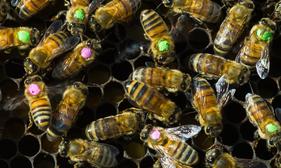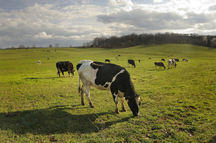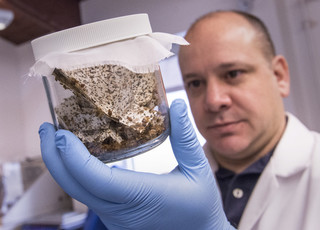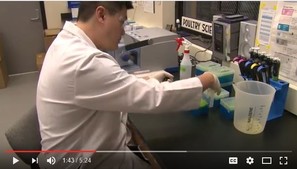|
|
|
Fresh from the Field is a weekly album showcasing transformative impacts made by grantees funded by the National Institute of Food and Agriculture.
April 13, 2017
|
|
Success Stories
 Technology to tend your garden
With NIFA funding,
researchers at Purdue University created the Purdue Plant Doctor, a
suite of apps that offers high-resolution photos to help users identify plant
disorders in nearly 200 plants, such as trees, annuals, perennials, and
tomatoes.
Recent updates include
resources that help users manage established invasive species like emerald ash
borer or the Asian longhorned beetle. Homeowners concerned about bees are
guided to solutions that protect pollinators.
Each app helps the user
diagnose the problem by asking a series of basic questions on the plant
species, the season, and other questions to help narrow down the potential
causes of the problem.
Read
the Purdue story here.
|
 Study: Too many antibiotics pose harm for bees and humans
A decade ago,
millions of bees mysteriously disappeared leaving farms with fewer pollinators
for crops. What came to be known as Colony Collapse Disorder, the explanation
for the event included exposure to pesticides, habitat loss and bacterial
infections, but scientists now say antibiotics given to bees could also
play a role. Researchers at the University of Texas at Austin discovered
that honeybees treated with a common antibiotic were half as likely to survive
the week after treatment compared with a group of untreated bees, a finding
that may have health implications for bees and people alike.
The scientists found the antibiotics cleared out beneficial
gut bacteria in the bees, making way for a harmful pathogen, which also occurs
in humans, to get a foothold. The research is the latest discovery to indicate
overuse of antibiotics can sometimes make living things, including people,
sicker.
Bees and humans
both have a natural community of microbes in their guts, called a gut
microbiome, which helps a variety of functions including modulating behavior,
development and immunity.
Read more about the research here.
|
 Cattle and soil health
Soil health is an
underappreciated, but critical element in a thriving agroecosystem. Soil
microbial health helps sustain ecosystem services such as climate regulation,
soil fertility, and food production.
Scientists
at Virginia Polytechnic Institute and State University (Virginia Tech) have
found drastic changes in the bacterial and fungal makeup of soil near manure
from cattle that received antibiotics.The scientists analyzed
soil samples from 11 dairy farms across the United States and found that the
amount of antibiotic-resistant genes was 200 times greater in soil near manure
piles than other soil.
This project was supported by the Agriculture Food and Research Initiative (AFRI).
Read the Virginia Tech story here.
|
News Coverage
 Breakthrough in
bed bug research
In
the last few decades, bed bug infestations have experienced a resurgence as a
global public health threat. Researchers at Pennsylvania State University
and North Carolina State University have developed a fungal
biopesticide that has the potential to control bed bugs that are insecticide
resistant. Their studies led to the creation of Aprehend, a patent-pending
compound based on Beauveria bassiana, a natural fungus that causes disease in
insects.
"The goal of this study was to evaluate the efficacy
of this product on an insecticide-susceptible lab strain of bedbug, and compare
that to its effect on three field-collected strains known to be resistant to
insecticides," said senior researcher Nina Jenkins. "We also compared
mortality of these four bedbug strains after exposure to either a commercial
pyrethroid insecticide or Aprehend."
Previous
studies have shown that the formulation can be used as a long-lasting barrier
treatment. Bedbugs that cross the barrier acquire fungal spores and spread them to other insects in the area, resulting in a more than 95 percent mortality rate within a week.
Read the Penn State article here.
|
 Helping kids fight obesity
According
to the 2013 Colorado Child Health Survey, one in four children between the ages
2-14 are obese. Some
of the factors that lead to childhood obesity are a lack of access to
nutritious food, affordable produce, overeating, and exposure to unhealthy food options. Colorado
State University’s Fuel for Fun: Cooking with Kids
Plus Parents and Play is a school-based program that promotes nutrition and
physical activities to fourth graders and their families. This Agriculture
and Food Research Initiative (AFRI) funded project was implemented in eight local schools with the long-term goal of reducing childhood obesity. Fuel for
Fun has reached nearly 1,000 students and their families
in the Northern Colorado schools.
Check out the infographic here.
|
Video

Pathogens without
borders
The
poultry industry, which contributes $440 billion annually to the economy and employs
500,000 people, is experiencing a health threat from the avian pathogenic Escherichia
coli (APEC), a major cause of infections in poultry. With
funding from NIFA’s Agriculture
and Food Research Initiative (AFRI), scientists at Iowa
State University and the Roslin Institute at the University of Edinburgh are
discovering ways to reduce the negative impact of APEC on the poultry industry by developing complementary treatment
approaches, such as vaccines and and selective breeding.
Their
findings show how genes and immune response help combat APEC. Researchers are
pinpointing which immune cell types are key to fighting the disease.
Watch the video here.
|
Tweet of the Week
#NIFAIMPACTS

|
|

For more NIFA Impacts, visit nifa.usda.gov/impacts or the Land-Grant University Impacts website. Send us your NIFA-funded impacts at impactstories@nifa.usda.gov or share them with USDA_NIFA on Twitter #NIFAimpacts.
NIFA invests in and advances agricultural research, education, and extension and promotes transformative discoveries that solve societal challenges.
Fresh from the Field is a weekly compendium of news and information that may be of interest to land-grant and non-land-grant universities, NIFA stakeholders, and other subscribers.
Editor: Falita Liles; Co Editor: Carlos Harris
|
|